
Talking Heads were an American rock band formed in New York City in 1975. The band was composed of David Byrne, Chris Frantz (drums), Tina Weymouth (bass), and Jerry Harrison. Described as "one of the most critically acclaimed groups of the '80s," Talking Heads helped to pioneer new wave music by combining elements of punk, art rock, funk, and world music with "an anxious yet clean-cut image"; they have been called "a properly postmodernist band."

Ambient music is a genre of music that emphasizes tone and atmosphere over traditional musical structure or rhythm. It is often "peaceful" sounding and lacks composition, beat, and/or structured melody. It uses textural layers of sound that can reward both passive and active listening and encourage a sense of calm or contemplation. The genre is said to evoke an "atmospheric", "visual", or "unobtrusive" quality. Nature soundscapes may be included, and the sounds of acoustic instruments such as the piano, strings and flute may be emulated through a synthesizer.

Another Green World is the third solo studio album by English musician Brian Eno, released by Island Records on 14 November 1975. The album marked a transition from the rock-based music of Eno's previous releases towards his late 1970s ambient work. Only five of its fourteen tracks feature vocals, a contrast with his previous vocal albums.
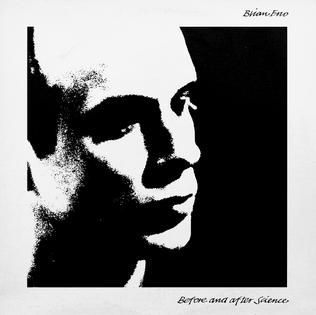
Before and After Science is the fifth solo studio album by English musician Brian Eno, originally released by Polydor Records in December 1977 in the United Kingdom and by Island U.S. soon after. Produced by Eno and Rhett Davies, it is the first of Eno's popular music works to be published under his full name.
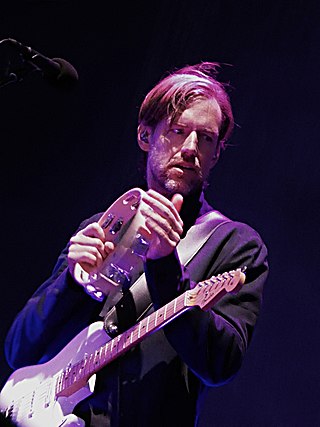
Edward John O'Brien is an English guitarist, songwriter and member of the rock band Radiohead. He releases solo music under the name EOB.

Remain in Light is the fourth studio album by the American rock band Talking Heads, released on October 8, 1980, by Sire Records. The band's third and final album to be produced by Brian Eno, Remain in Light was recorded at Compass Point Studios in the Bahamas and Sigma Sound Studios in New York in July and August 1980.

Taking Tiger Mountain (By Strategy) is the second solo studio album by English musician Brian Eno (mononymously credited as "Eno"), released in November 1974 by Island Records. Unlike his debut album Here Come the Warm Jets, which featured 16 musicians, this album utilized a core band of five instrumentalists: Eno (keyboards, guitar), Phil Manzanera (guitar), Brian Turrington (bass guitar), Freddie Smith (drums), and Robert Wyatt (percussion). Manzanera also participated in the writing and production. To help guide the musicians, Eno and Peter Schmidt developed instruction cards called Oblique Strategies to facilitate creativity during the recording process.
Michael Brook is a Canadian guitarist, inventor, music producer, and film music composer. He plays in many genres, including rock, electronica, world music, minimalism and film scores. His collaborations with musicians around the world have made him "one of the most sought-after producers in the music industry." Born in Toronto, Ontario, Canada, Brook lives in Los Angeles. He is the creator of the Infinite Guitar.

Cluster & Eno is a collaborative album by German electronic music group Cluster and English ambient musician Brian Eno. The style of this album is a collection of gentle melodies: a mixture of Eno's ambient sensibilities and Cluster's avant-garde style.
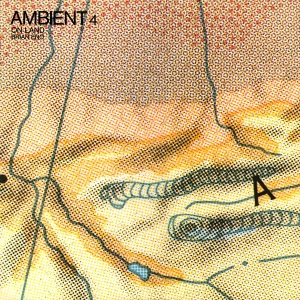
Ambient 4: On Land is the eighth solo studio album by Brian Eno, released in March 1982 by EG Records. It was the final edition in Eno's Ambient series, which began in 1978 with Ambient 1: Music for Airports. The album was released to critical acclaim, and is recognised along with its predecessors as a landmark album in the history of the ambient genre.

Apollo: Atmospheres and Soundtracks is a studio album by the British musician and producer Brian Eno, the Canadian producer Daniel Lanois, and Brian Eno's brother, composer Roger Eno. It was released on 29 July 1983 through EG Records. The music was originally written for For All Mankind, a documentary film by Al Reinert about the Apollo program, though the film was not released until 1989. The score was written and performed by the trio.

Here Come the Warm Jets is the debut solo studio album by English musician Brian Eno, released on Island Records on 8 February 1974. It was recorded and produced by Eno following his departure from Roxy Music, and blends glam and pop stylings with avant-garde approaches. The album features numerous guests, including several of Eno's former Roxy Music bandmates along with members of Hawkwind, Matching Mole, Pink Fairies, Sharks, Sweetfeed, and King Crimson. Eno employed unusual directions and production methods to coax unexpected results from the musicians.
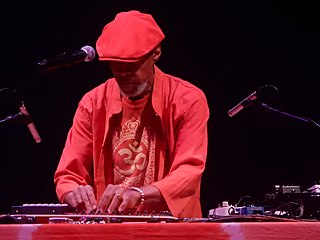
Laraaji is an American multi-instrumentalist specializing in piano, zither and mbira. His albums include the 1980 release Ambient 3: Day of Radiance, produced by Brian Eno as part of his Ambient series.

"With or Without You" is a song by Irish rock band U2. It is the third track on their fifth studio album, The Joshua Tree (1987), and was released as the album's lead single on 16 March 1987. The song was the group's most successful single at the time, becoming their first number-one hit in both the United States and Canada by topping the Billboard Hot 100 for three weeks and the RPM national singles chart for one week, with a further three weeks at number two.

My Life in the Bush of Ghosts is the first collaborative studio album by Brian Eno and David Byrne, released in February 1981. It was Byrne's first album without his band Talking Heads. The album integrates sampled vocals and found sounds, African and Middle Eastern rhythms, and electronic music techniques. It was recorded before Eno and Byrne's work on Talking Heads' 1980 album Remain in Light, but problems clearing samples delayed its release by several months.
Russell Mills is a British artist. He has produced record covers and book covers for Brian Eno, the Cocteau Twins, Michael Nyman, David Sylvian, Peter Gabriel, and Nine Inch Nails.

Fourth World, Vol. 1: Possible Musics is an album by Jon Hassell and Brian Eno. It was recorded at Celestial Sounds in New York City and released in 1980 by Editions EG, an imprint label of E.G. Records. "Fourth world music" is a musical aesthetic described by Hassell as "a unified primitive/futuristic sound combining features of world ethnic styles with advanced electronic techniques." The album received praise from many critics.

Brian Peter George St. John le Baptiste de la Salle Eno, also mononymously known as Eno, is an English musician, songwriter, record producer and visual artist. He is best known for his pioneering contributions to ambient music and electronica, and for producing, recording, and writing works in rock and pop music. A self-described "non-musician", Eno has helped introduce unconventional concepts and approaches to contemporary music. He has been described as one of popular music's most influential and innovative figures. In 2019, he was inducted into the Rock and Roll Hall of Fame as a member of Roxy Music.
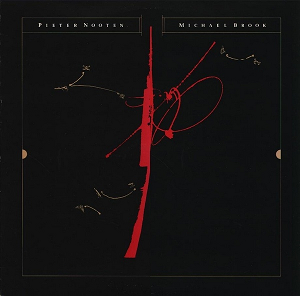
Sleeps with the Fishes is the lone collaborative album from Clan of Xymox founding member Pieter Nooten and Canadian guitarist/producer Michael Brook, released by 4AD on 12 October 1987. Intended as Nooten's debut solo album after a brief split from Clan of Xymox, the record turned into a collaboration with Brook after a suggestion from 4AD label founder and boss Ivo Watts-Russell. Though not a huge commercial success, Sleeps with the Fishes was described by AllMusic as "essential listening for fans of 4AD, ambient music, minimalism, experimental electronic music, and morose themes alike... an overlooked masterpiece."

Cobalt Blue is an album by the Canadian musician Michael Brook, released in 1992. Brook supported the album with a North American tour, playing some shows with John Cale. The album was reissued in 1999, with an additional disc of live material.


















